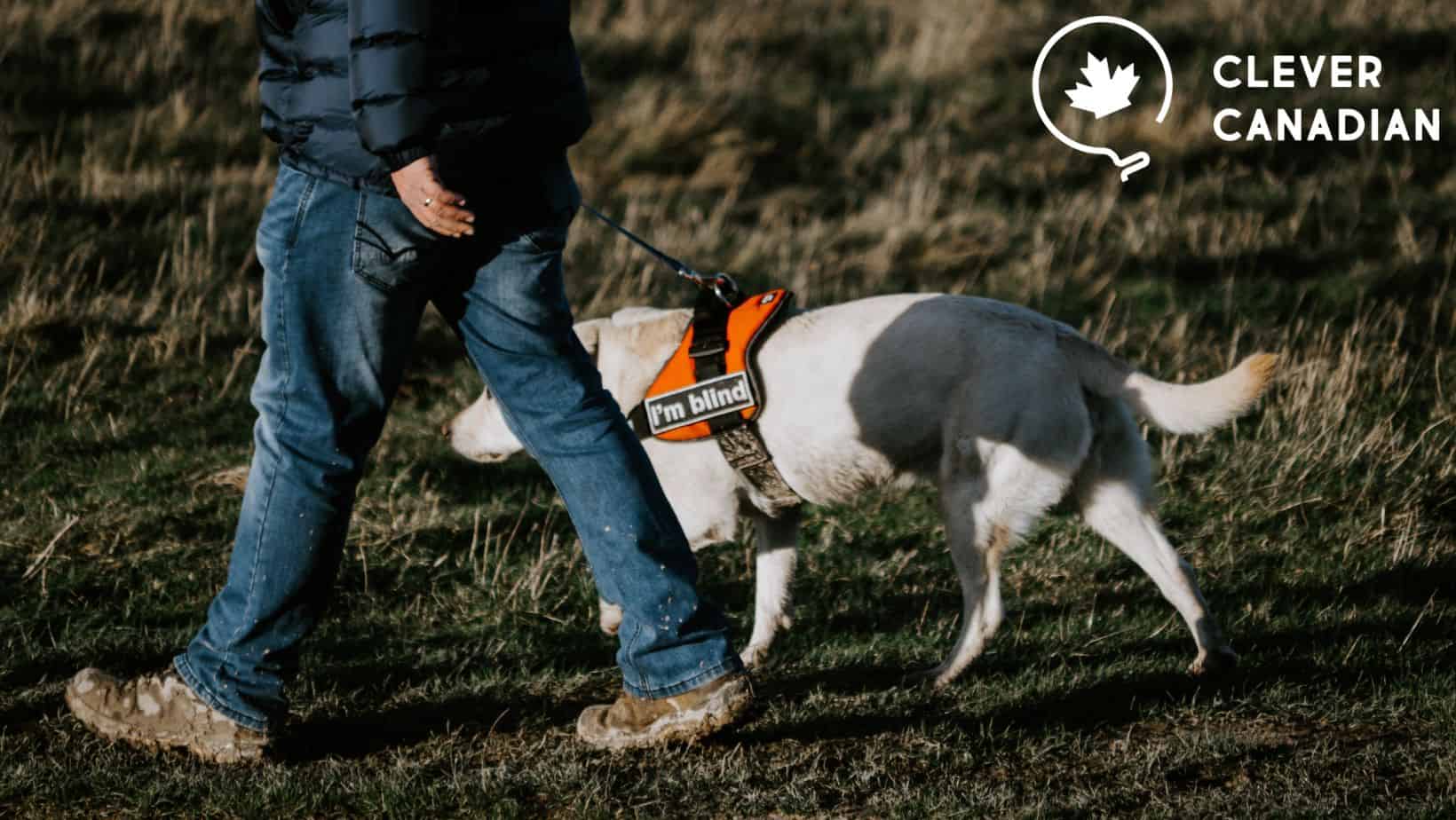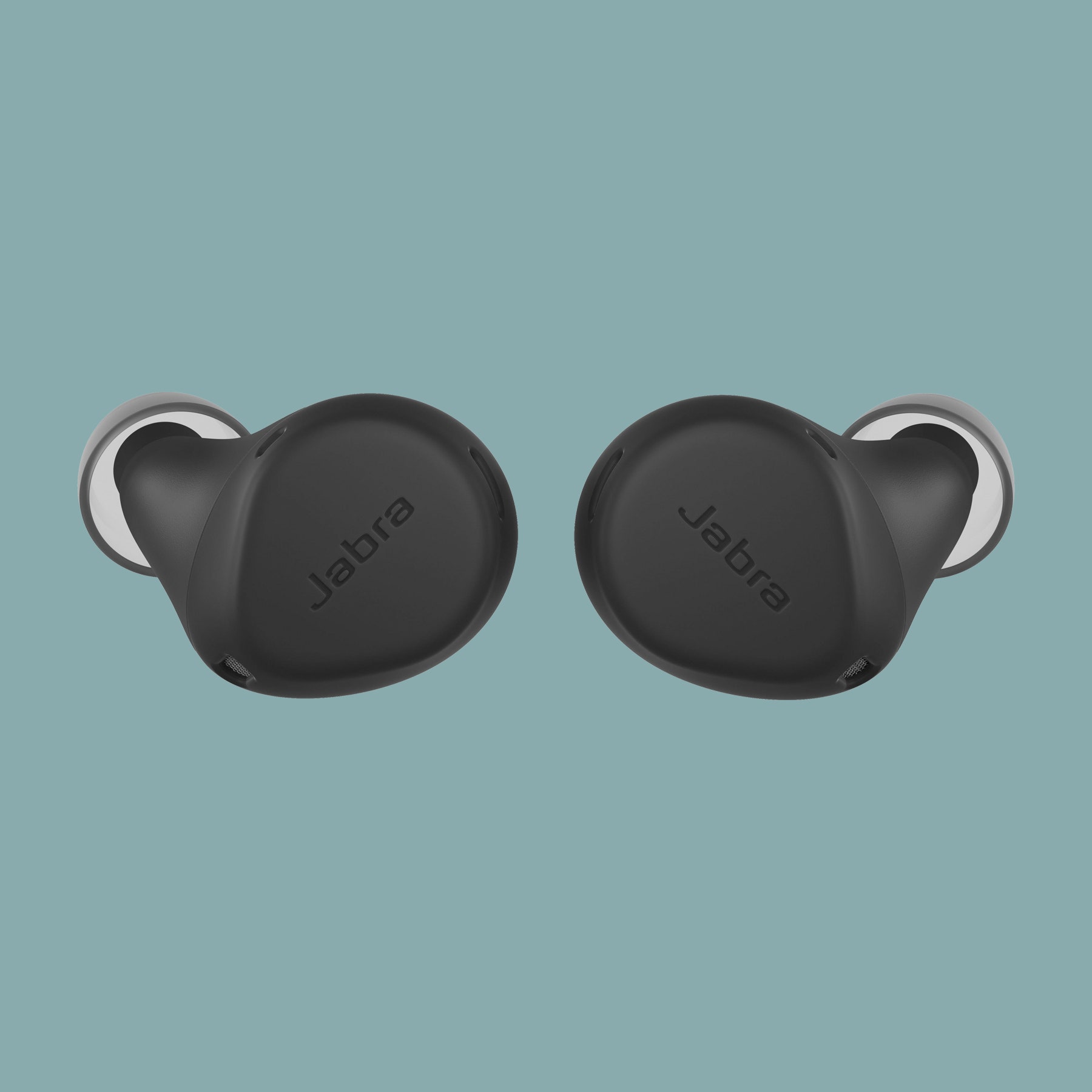Categories > Guides and Tips

Getting a Guide Dog in Canada: Everything You Need to Know
- How are guide dogs different from pets?
- How does one get a guide dog in Canada?
- Can immigrants get a guide dog in Canada?
- What is the process of getting a guide dog in Canada?
- Step 1: Submit an application form
- Step 2: Wait for a confirmation
- Step 3: Submit the paperwork
- Step 4: Home visit
- Step 5: Wait for approval
- Step 6: Attend your class
- Step 7: Graduate with your guide dog
- What are the costs of getting a guide dog in Canada?
- Where can I get a guide dog in Canada?
- Is there a waitlist when getting guide dogs in Canada?
- Common Misconceptions about Guide Dogs
- Guide dogs know how to cross the street.
- Guide dogs are emotional support animals.
- Guide dogs are always working.
- Guide dogs are guard dogs.
- Guide dogs are unhappy because they're always working.
- FAQ about Getting a Guide Dog in Canada
People with visual impairment need assistance safely crossing the street and going places – that’s where guide dogs come into the picture. They are highly trained animals that can help their person move about safely.
To get a guide dog in Canada, the individual must have a medical report proving visual impairment and meet the required age, depending on the guide dog organization.
Some facilities offer them free of charge and require the handler to be a permanent resident of Canada.
If you want to learn more about getting a guide dog in Canada, stick around as we’ll discuss the functions of a guide dog, why you may need one, and where to get one!!
How are guide dogs different from pets?

A common misconception about guide dogs is they’re just like any other pet at home. That may be true, but it’s also different…like, really different!
Guide dogs are working dogs. They’ve gone through special training to have the ability to assist people with low or no vision when getting places, like crossing a street.
You will find these dogs wearing harnesses, which basically means they’re currently working, and you must not distract them. But we’ll talk about that later on.
You will notice that guide dogs are calm. You won’t hear them barking when they see another dog or a cat. That’s because of the special training the guide dogs underwent since they were little puppies.
Moreover, the training includes socialization in different situations and places. This allows them to remain calm regardless of the area, people, animals, and smells.
In addition, they were trained at a young age to respond to their handler’s commands. Now, those are smart dogs!
How does one get a guide dog in Canada?

You can get a guide dog in Canada through non-profit organizations. You are eligible if you are legally blind and a citizen or permanent resident.
You also need a stable home setting and commitment to work with the guide dog. Age restriction will also depend on the organization.
If you want to get a guide dog, you can apply through dog programs in Canada. Each will have its own eligibility requirements, so you may not necessarily get accepted immediately.
But what about immigrants who need a guide dog in their everyday life? Can they apply to these programs?
Can immigrants get a guide dog in Canada?
Immigrants can get a guide dog in Canada, but it depends on the dog program’s requirements. You still need to have low or no vision before getting approved.
The requirements for immigrants are pretty much the same as Canadian citizens and permanent residents. But before applying, make sure you have a good home environment and have managed to build a daily routine.
It’s a common requirement from many guide dog organizations to familiarize your dog with a routine so they can get used to your schedule. So, what’s the rest of the process, exactly?
Let’s talk about that below!
What is the process of getting a guide dog in Canada?
The process of getting a guide dog starts with an application form. You need to apply to the organization first, which will assess your eligibility.
They need to make sure you are mentally ready to handle a guide dog. They will also evaluate if you can train the dog physically.
Let’s break down the process in this step-by-step guide so you can easily apply for a guide dog in Canada!
Step 1: Submit an application form
Many organizations for guide dogs have online application forms. You need to complete this so they can evaluate your credibility.
These forms will generally ask for your personal information, like name, age, and location. In addition, they will ask just a few general medical questions, including physical mobilities and if you have low or no vision at all.
The common criteria in many dog programs are the following:
- you need to be registered as legally blind or have low or no vision at all
- have a supportive and stable home environment
- be independently mobile
- have a strong desire to take care of a guide dog
Age restrictions will vary depending on the guide dog program. Some will accept kids as young as 12, but most require 16 years old and above.
It’s also important to check the dog program’s criteria regarding your residency status. Some will only accept permanent residents or Canadian citizens.
Step 2: Wait for a confirmation
Getting a guide dog in Canada is not going to be a quick process. You most likely won’t get an immediate response but will get a consultation if you are eligible.
Why does it take so long? Many organizations have a waiting list because there are not enough guide dogs (and trainers and volunteers) for many applicants.
Step 3: Submit the paperwork
If you are eligible, you need to submit the necessary forms, which will depend on the guide dog program. But it will mostly be medical forms from your doctor to confirm you need a guide dog in your daily life.
It’s just to confirm that you actually need a guide dog!
Step 4: Home visit
Yup, you’ll get a home visit before getting approved! This is an important process because they will evaluate your home environment, your ability to work with the dog, and other necessary criteria they require.
Even though it’s only you who will apply, the guide dog will live with you and your family in your home. The dog program will assess the home environment because they need to ensure the guide dog will have stability while living with you.
Step 5: Wait for approval
You just need to wait, which can take months or years. There really isn’t a set time frame, but they will notify you if you are approved to get a guide dog.
Some applicants had to wait around two years before they got a guide dog. So, it’s going to need a lot of patience from you.
Step 6: Attend your class
Getting a guide dog means training an animal. You need to attend classes so you’ll know how to train and work with a guide dog.
The instructors will match you will a guide dog based on your conditions. You don’t select one on your own because each person will have different needs, like size, home environment, and other criteria.
Many programs require you to live in a facility with other applicants for a couple of weeks. Here, you will learn all the necessary training tools that you’ll need for yourself and your guide dog.
Step 7: Graduate with your guide dog
Once all the classes are done and you’ve passed, you and your guide dog will graduate together. After that, you can finally go home with your guide dog and start a brand new life full of support, companionship, and independence!
What are the costs of getting a guide dog in Canada?
Getting a guide dog is free of charge from Canadian organizations. They will pay for the training, which they get through donations.
Once you get the dog, you are solely responsible for the veterinary and food costs. You can ask some organizations for vet recommendations that provide quality care.
You might be thinking, “I thought guide dogs are free?” Yes, applicants don’t have to pay for their guide dogs.
But these dogs will live with you, which means you need to have the financial capacity to buy their food, toys (yes, guide dogs play with their families!), and vet bills.
Before graduating, guide dogs have already been neutered or spayed, vaccinated, and checked for diseases.
From birth, these dogs get the best care to ensure they’re healthy and capable of assisting their partners. But now, it’s your responsibility to cover veterinary costs.
Training a single guide dog can cost around $35,000 to $50,000. How do non-profit organizations fund these expensive fees? Through donations, of course!
Donors give people with visual impairments a chance to get paired with a guide dog free of charge. But once the dog leaves the facility, you will be the handler responsible for future food and medical costs.
Don’t worry, though! There are programs that provide assistance for veterinary expenses. But it’s important to note that as the handler, it’s now your responsibility to apply for it and not the facility.
Where can I get a guide dog in Canada?
You can get a guide dog through guide dog programs and non-profit organizations in Canada. Some will have multiple locations in different provinces, while others are exclusive to a specific region.
We suggest checking the Canadian Association of Guide & Assistance Dog Schools to find the available organizations offering guide and service dogs per province.
There, you can find service dogs for people with disabilities other than visual impairment, including autism, hearing impairment, and Post Traumatic Stress Disorder (PTSD).
But keep in mind that some facilities are not currently accepting applicants. It’s due to a long waiting list of existing applicants.
Moreover, some applicants are waiting to be paired with a guide dog. Not all trained puppies grow up to be guide dogs.
Sometimes, they are not meant to assist but want to become pets at home instead. That’s perfectly okay!
There is a waiting time until new puppies for training are born. You see, it takes up to two years until they’re fully trained.
Currently, there’s a high demand for guide dogs in the country, and the low supply has forced some facilities to close applications.
We’ve made a table below showing you some of the most trusted guide dog organizations in Canada and their requirements.
| Organization | Eligibility Criteria | Fee | Contact Details |
| Canadian Guide Dogs for the Blind | • 16 years old and above •Registered as legally blind • Canadian permanent resident • Desire to continue the training process • In reasonable physical health • Must be independently mobile • Capability to walk a minimum of two routes Stable home environment | $1.00 fee upon graduating | Website: https://www.guidedogs.ca/Phone: +1 (613) 692-7777 Email: [email protected] |
| Mira Organization | • 11 years old and above • Blind, deaf-blind, low vision or visual and mobility impairment • Visual and medical report to confirm disability • Ability to interact with the dog • In good physical shape, except for visual and mobility disability • New applicants must be Canadian residents | Free of charge | Website: https://www.mira.ca/ Phone: (450) 795-3725 Email: [email protected] |
| Lions Foundation of Canada Dog Guides | • 12 years old and above • Blind or visually impaired • Ability to work with the guide dog • Stable home environment | Free of charge | Website: https://www.dogguides.com/ Phone: (800) 768-3030 (administration staff) Email: [email protected] |
Is there a waitlist when getting guide dogs in Canada?
There is a waitlist for getting a guide dog in Canada. Many factors have affected this, like the COVID-19 pandemic, but mainly because there aren’t enough guide dogs for many applicants.
Guide dogs undergo training for two years, and not all pass the exam. If a dog fails the final test, it can go through additional months of training or not pass as a guide dog at all.
It’s common knowledge that the COVID-19 pandemic affected us all. Stuck at home every single day? That was hard!
Unfortunately, it also affected dog training programs. The restrictions and lockdowns greatly affected the number of foreign-trained dogs entering the country.
Furthermore, the locally-trained dogs faced restrictions, too. Puppies training to be guide dogs live with their foster families, and due to the limitations they faced, they needed to adjust schedules and programs.
There’s also a shortage of trainers and volunteers. Because of this, there are not enough people that can provide training and care for future guide dogs in the country.
Meanwhile, the demand for guide (and service) dogs increased. As a result, there’s a shortage of supply.
Currently, there’s a long waitlist for guide dogs. Some even up to two years (or more!)! Due to the long list and high demand, some organizations have been forced to close off applications for guide dogs.
Common Misconceptions about Guide Dogs

There are many misconceptions about guide dogs. These myths spread false information that negatively affects guide dogs and their partners. Let’s discuss these here because it’s time to squash these rumours!
1. Guide dogs know how to cross the street.
Guide dogs cannot read signs or traffic lights. They’re colour-blind and cannot tell if the light is green.
Furthermore, they are trained to assess the environment and will not cross the street if there is oncoming traffic. That’s what they were trained to do!
So, how do they cross the street? It’s their handler that tells them when to cross the street. The handler can tell the surge of traffic through their mobility training.
So, if they think it’s safe to do so, they will signal their dog to cross the street. But guide dogs are trained not to walk in front of moving cars.
2. Guide dogs are emotional support animals.
Guide dogs go through training from puppies to adulthood. A certified organization specifically chooses them based on their personalities and calm demeanour. Additionally, they have the capability to perform tasks for their handler with disability.
In contrast, an emotional support animal does not go through expensive years of training. In fact, they’re more of an emotional companion to their owner.
3. Guide dogs are always working.
Most people see guide dogs on the job. They have their harness on and will calmly walk next to their handler.
Guide dogs know when they need to work. They also know when to relax and play. They are dogs, after all, and still need love, affection, and playtime.
4. Guide dogs are guard dogs.
Nope! Guide dogs were not trained to protect someone when attacked. The protection they do for their handlers is through assistance when going places.
You will notice that most guide dogs are Golden Retrievers and Labrador Retrievers. That’s because they are bred to have a calm demeanour, loyal, and are devoted to their partners. They’re intelligent, too!
5. Guide dogs are unhappy because they’re always working.
Guide dogs are not always working. They sleep, play, and eat. They’re just like regular dogs, except with assistance training.
When they’re not working, they will do normal things that dogs do. That’s why during the application process, having a stable home environment is important for the dog to have a daily routine (just like any pet!).
What Not to Do When Seeing a Guide Dog
1. Always ask before petting a guide dog.
Many people think you are not allowed to pet a guide dog. The truth is, you can. But remember to ALWAYS ASK FIRST.
It will depend on the handler if they feel it’s safe for strangers to pet their guide dog. If they say no, just walk away and respect the decision.
We’ve heard many stories of people getting angry that they can’t pet a guide dog. Remember that it’s not your decision, and it’s not your dog.
2. Do not let your dog “meet” the guide dog.
Remember, when they’re wearing their harness, they’re working. If you’re in a meeting, you wouldn’t want a stranger to walk up to you to play, right?
Moreover, guide dogs need to concentrate. This is important for the safety of their handlers. Barking can distract guide dogs.
So, just keep your dog away from guide dogs and maybe invest in a training school?
3. Do not talk to the dog. Talk to the handler.
It’s a guide DOG, not a person. Dogs won’t understand you, no matter how high your voice is. It’s just a matter of etiquette to speak to the person.
Let’s say there’s a pothole down the road; tell it to the handler. It’s the person who signals the guide dog and has to get somewhere.






